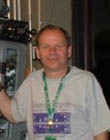|
|
 
|
|
Author
|
Topic: Drawing of reflector Strong Ultra 80
|
|
|
|
|
|
|
|
|
|
|
Jan Eberholst Olsen
Film Handler
Posts: 12
From: Oslo, Oslo, Norway
Registered: Aug 2017
|
 posted 09-21-2017 03:37 AM
posted 09-21-2017 03:37 AM





Sam, thank you very much for your input.
I have thought about the Kinoton way, but I really like the even light output from the Strong lamphouse, the beam spreader for 70mm and the nice manual douser. I can get a European specialist company (Weule) to make a glass reflector, but I am concerned what will happen inside the lamphouse heat wise. We are thinking of removing all electronics from inside the lamphouse, and just use a DC igniter from Kinoton. The rest of the electronics could be outside of the lamphouse (underneath the table on the NorelcoAA). If there is "nothing inside" except the DC igniter, does it matter if we change the design? We will measure the air flow inside the lamphouse, to make sure the bulb and mirror will get the correct cooling (we now use a Pabst fan when the original one stopped a few years back)
Will a metal mirror loose its reflecting capability when stored in an office environment for lets say 10 - 20 years?
A glass reflector can be delivered with the same color temperature (or at least they say they can), which is very important especially for change-over operation of black and white movies. If the glass reflector is more proven to maintain its reflection capabilities lets say 50 years from now, it may be the right way forward (but a difficult and expensive one).
| IP: Logged
|
|
|
|
|
|
Robert Brunson
Film Handler
Posts: 1
From: Temecula, Ca, USA
Registered: Oct 2017
|
 posted 10-16-2017 06:46 PM
posted 10-16-2017 06:46 PM





Hello all,
Rob Brunson from Optiforms here - Yes, we pretty much provided all of the electroformed dichroic coated reflectors, and many other downstream optics, for most of the projector manufactures, Ballantyne/Strong, Christie, Keisley, Cinemeccanica, Eprad, Texas Instruments, as well as a lot of the retro reflector sets used in the early part of Digital. We still offer AMR (Aftermarket Replacements)versions of all of the reflectors. Regarding the coating, a lot has changed over the years with regards to coating materials and coating designs. Our current DCC (Dichroic Cold Coating)is far superior to the early stuff. DCC coated reflectors have a porous coating, especially the older ones, and they do take on moisture over the years, and when fired up with a nice hot Xenon source it can be detrimental to these older coatings. As a few had posted earlier, these electroformed DCC coated reflectors are designed to maximize the %R in the visible region, while absorbing the IR and UV. This creates a lot of heat being soaked into the reflector, so it needs to be cooled properly. Glass reflectors obviously reflect the same light, but transmit the unwanted light, typically meaning a cooler running reflector, but you also need to get that heat exhausted. Basically two different types of designs, but designed to do the same thing, illuminate a screen. There are pros and cons to both types of reflectors, glass and electroformed.
| IP: Logged
|
|
|
|
|
|
All times are Central (GMT -6:00)
|
|
Powered by Infopop Corporation
UBB.classicTM
6.3.1.2
The Film-Tech Forums are designed for various members related to the cinema industry to express their opinions, viewpoints and testimonials on various products, services and events based upon speculation, personal knowledge and factual information through use, therefore all views represented here allow no liability upon the publishers of this web site and the owners of said views assume no liability for any ill will resulting from these postings. The posts made here are for educational as well as entertainment purposes and as such anyone viewing this portion of the website must accept these views as statements of the author of that opinion
and agrees to release the authors from any and all liability.
|

 Home
Home
 Products
Products
 Store
Store
 Forum
Forum
 Warehouse
Warehouse
 Contact Us
Contact Us




 Printer-friendly view of this topic
Printer-friendly view of this topic












